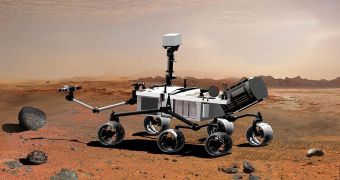The ambitious design of the Mars Science Laboratory (MSL) has sparked, since it first appeared, criticism as to the number of instruments it includes, and also on account of its size. Quite simply put, the MSL, which has recently been appropriately named Curiosity, is the largest rover ever to be sent to the Red Planet, dwarfing the MER twin rovers Spirit and Opportunity. At this point, inside a clean room at NASA's Jet Propulsion Laboratory (JPL), in Pasadena, California, the rover is coming together, and the real genius behind its construction is finally coming into view.
The reason why the construction is moving slowly is the fact that the mission has been recently postponed until 2011, which gives engineers working on the project more than enough time to do everything by the book. They have to figure out how to make all the complex and very expensive instruments aboard the rover fit together. Among the most outstanding ones, scientists in the project mention a laser that can zap rocks and analyze their composition, as well as onboard chemistry laboratories, which can identify organic molecules inside the Martian soil.
According to the final sketches, the main body of the rover will be of the size of a small car, Space informs. It will weigh in at 2,040 pounds (925 kg), and MSL Deputy Project Scientist Joy Crisp says that the project is still “in the early stages of assembly.” A few kinks in the assembly process still exist, the official has revealed, but there is more than enough time left to sort them out and get Curiosity on its wheels. Right now, none of its instruments is attached to the rover.
Crisp also adds that the main problem the team now faces is getting Curiosity's actuators to work in the extremely low temperatures of Mars. These devices are small motors that control the craft's wheel, mast and robotic arm movements, and they have to withstand harsh meteorological conditions. The MSL will land on Mars in a fairly low-temperature area, although not as close to the polar areas as the Phoenix Mars Lander did back in 2008. However, it will be further North than Spirit and Opportunity.
The main missions that MSL was assigned to are related to investigating local geology, chemistry, as well as potential signs of past or present biological activity on the Red Planet. The biggest question on everyone's lips right now is “Are there organics on Mars?” and it's up to the aptly named Curiosity to answer this burning problem.

 14 DAY TRIAL //
14 DAY TRIAL //